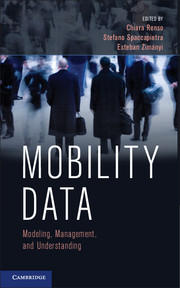Preface
Published online by Cambridge University Press: 05 October 2013
Summary
From the invention of the wheel to moon-landing rockets, technological progress over thousands of years has produced increasingly powerful and efficient transportation means, thus making moving easier and easier. Most recent progress in telecommunications has added new facets to mobility. We have now the ability to automatically keep track of our travel routes and even document them with information such as photos about the places we have been. This prompted the surge of small to huge databases holding mobility data, that is, the data about where and when we have been all over the world as well as during our daily trips to reach our workplace. Complementarily, more and more applications in a great variety of domains have been or are being developed to make intelligent use of mobility data.
While most of us are aware that our cellphones and cars equipped with a GPS facility do regularly generate signals conveying their geographical position (plus other data characterizing movement, e.g., acceleration and instant speed), not everybody is aware of what may happen later to this data, that is, how it can be used, by whom, and for what purpose. This book aims to introduce the potential answers to this question. The presentation of the material aims to make the book an easy read for all professionals (students included) in computer sciences and geoinformatics. Special attention has been given to show enough examples to optimize the understanding of the discussions.
- Type
- Chapter
- Information
- Mobility DataModeling, Management, and Understanding, pp. xv - xviiiPublisher: Cambridge University PressPrint publication year: 2013



